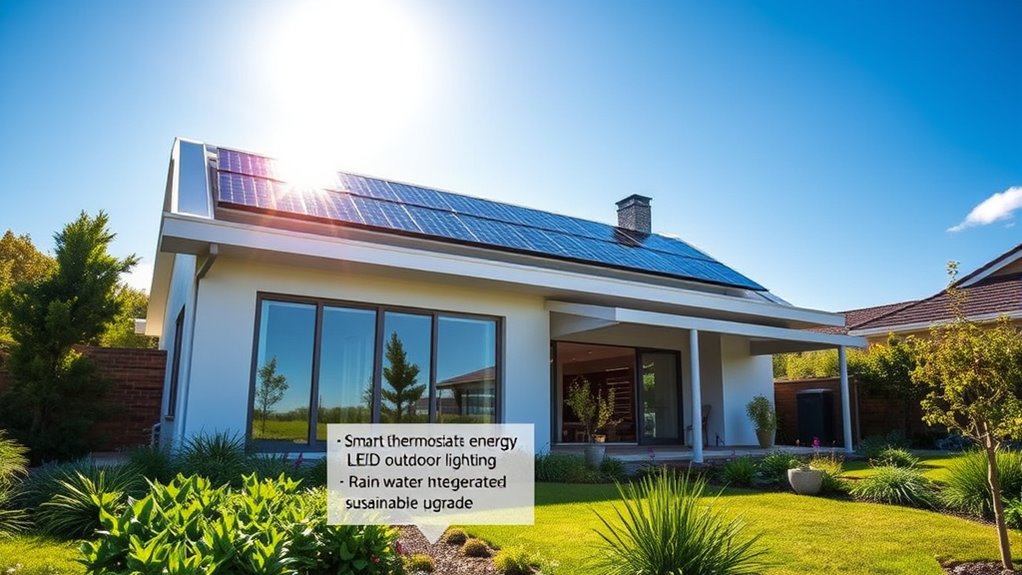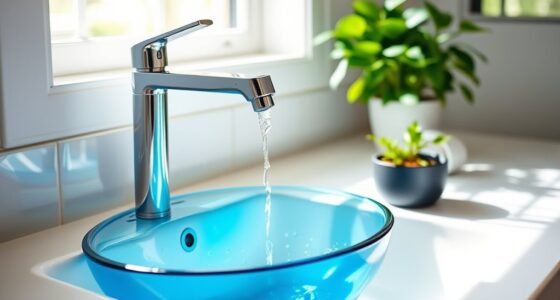To make your home more energy-efficient, focus on upgrading insulation, sealing leaks, and improving ventilation, which help reduce air loss and lower bills. Installing energy-efficient windows and smart thermostats allows better temperature control, while switching to LED lighting and ENERGY STAR appliances cuts electricity use. Adding weatherstripping and door sweeps keeps drafts out. Incorporating renewable energy sources, like solar panels, boosts savings further. Keep exploring to uncover more tips for a greener, cost-effective home.
Key Takeaways
- Improve insulation, sealing leaks, and upgrading ventilation to reduce energy loss and enhance indoor air quality.
- Install energy-efficient windows, doors, and smart thermostats to optimize heating and cooling efficiency.
- Switch to LED lighting and automate controls to lower electricity consumption.
- Upgrade to Energy Star appliances and incorporate renewable energy sources like solar panels.
- Implement weatherstripping, door sweeps, and additional insulation measures to further enhance home energy performance.
Improve Insulation and Sealing
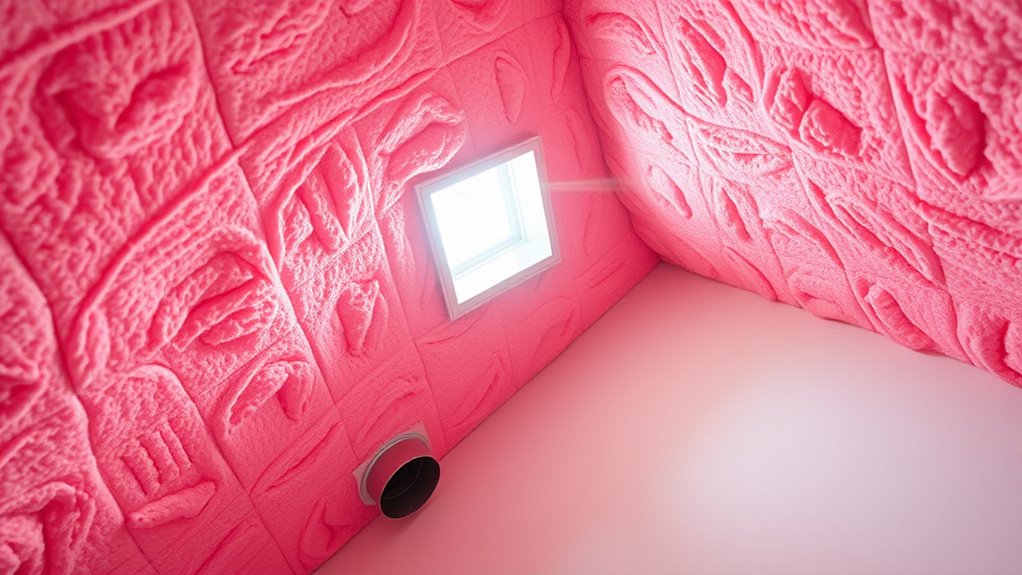
Improving insulation and sealing is one of the most effective ways to boost your home’s energy efficiency. When you reduce air leakage, you prevent warm or cool air from escaping through gaps and cracks. Sealing drafts around doors, windows, and vents stops cold spots and minimizes thermal bridging, which occurs when heat transfers through poorly insulated areas. Proper insulation in walls, attic, and floors creates a barrier that keeps temperature steady inside. Addressing thermal bridging directly reduces heat loss at key structural points. By sealing leaks and enhancing insulation, you’ll lower your energy bills and create a more comfortable living space. These improvements help your home resist unwanted air exchange, making your heating and cooling systems work more efficiently. Additionally, ensuring your stove complies with wood stove safety standards and maintaining proper ventilation are essential for safe and efficient heating.
Upgrade to Energy-Efficient Windows
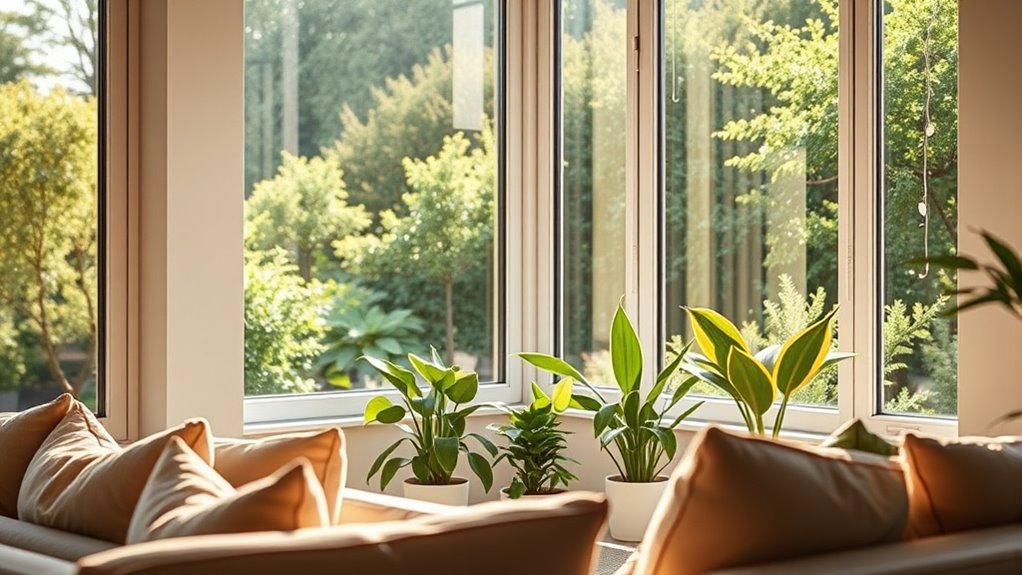
Have you considered upgrading to energy-efficient windows to boost your home’s performance? Double glazed windows are an excellent choice because they reduce heat transfer and improve insulation. When selecting new windows, focus on quality window frame materials like vinyl, fiberglass, or wood, which enhance durability and energy savings. These frames complement the insulating properties of double glazed panes, helping maintain comfortable indoor temperatures year-round. Properly installed, energy-efficient windows can considerably lower your heating and cooling costs while reducing drafts and outside noise. Additionally, smart window technology is emerging, allowing you to control sunlight and heat gain with automatised tinting or shading features. They also boost your home’s curb appeal. Keep in mind that the right combination of double glazed windows and high-quality frame materials makes a noticeable difference in overall energy efficiency and comfort for your household.
Install a Programmable Thermostat

Upgrading to energy-efficient windows helps reduce heat loss, but maintaining ideal indoor temperatures requires more precise control. Installing a smart thermostat allows you to set schedules that match your routine, maximizing energy savings. With a programmable thermostat, you can lower the temperature when you’re away or asleep, reducing unnecessary heating or cooling. This device learns your preferences and adjusts accordingly, ensuring comfort without waste. Additionally, color accuracy in your home’s temperature management can enhance overall comfort and efficiency.
| Time of Day | Temperature Setting | Savings Impact |
|---|---|---|
| Morning | 68°F | Moderate |
| Day | 60°F (away) | High |
| Evening | 72°F | Moderate |
| Night | 65°F | Low |
| Weekend | Custom schedule | Optimized |
A smart thermostat helps you control your home’s climate efficiently, delivering significant energy savings.
Switch to LED Lighting
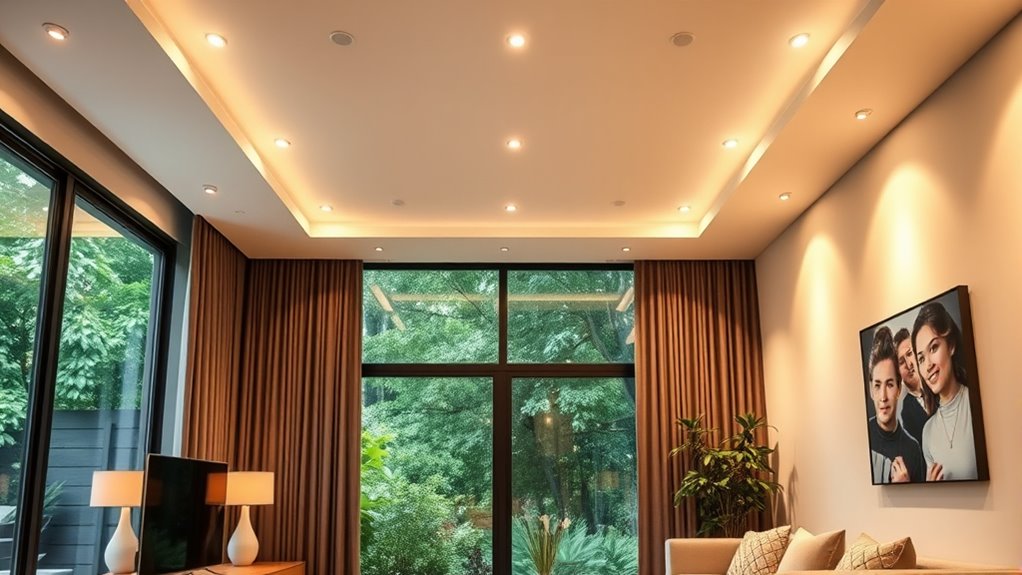
Switching to LED lighting is one of the simplest and most effective ways to reduce your home’s energy consumption. LEDs use considerably less power than incandescent bulbs and last much longer, saving you money over time. Many LED bulbs come with dimming options, giving you control over brightness and ambiance while conserving energy. Additionally, choosing bulbs with adjustable color temperature allows you to customize the lighting to suit different spaces and moods, from warm and cozy to cool and energizing. Installation is straightforward, and the variety of styles ensures you can upgrade fixtures throughout your home easily. By making this switch, you not only lower your energy bills but also create a more flexible, comfortable living environment. Incorporating energy-efficient lighting options can further enhance your home’s overall efficiency and sustainability.
Upgrade to Energy Star Appliances
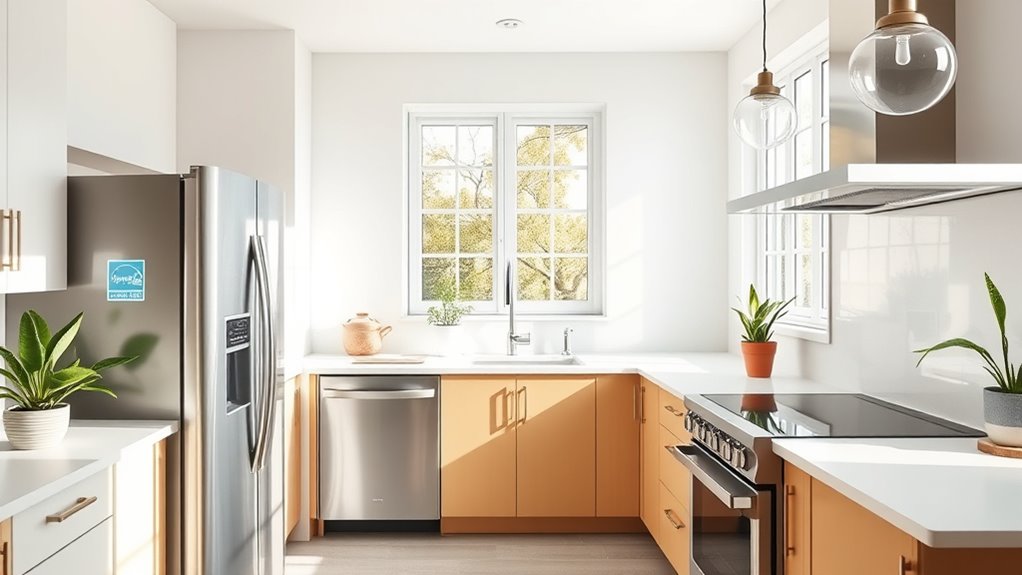
Choosing Energy Star appliances is one of the most effective ways to cut your home’s energy use. These appliances use advanced technology to operate efficiently, saving you money on energy bills. To maximize their benefits, perform regular appliance maintenance, such as cleaning filters and checking seals, which helps guarantee they run smoothly. Proper maintenance also extends the appliance lifespan, preventing premature breakdowns and costly replacements. Upgrading to Energy Star-rated refrigerators, washers, and dishwashers not only lowers energy consumption but also reduces water usage. Remember, newer appliances tend to be more durable and efficient, so investing in quality saves you money in the long run. Additionally, understanding energy efficiency standards can help you choose the most sustainable options for your home. By choosing these appliances and maintaining them well, you’ll enjoy lower bills and a more sustainable home.
Enhance Ventilation and Airflow
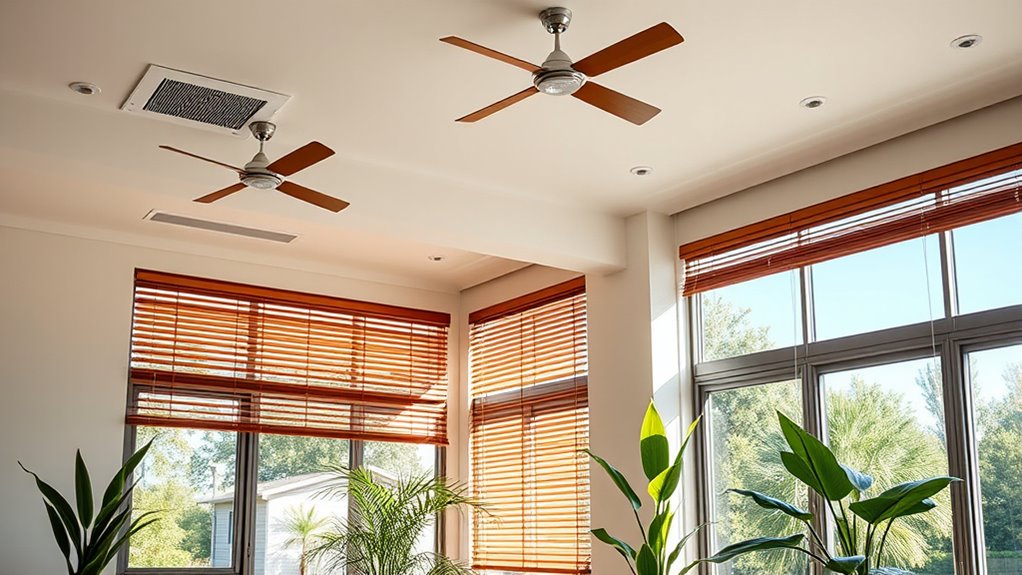
Improving your home’s ventilation and airflow can considerably boost energy efficiency and indoor comfort. Proper airflow optimization guarantees fresh air circulation while reducing indoor pollutants and humidity. Upgrading or maintaining ventilation systems, like exhaust fans and air exchangers, helps control indoor temperature and air quality. Consider installing energy-efficient ventilation systems, such as heat recovery ventilators (HRVs) or energy recovery ventilators (ERVs), to maximize airflow without wasting energy. Sealing leaks around windows, doors, and ducts also enhances airflow control, preventing drafts and unnecessary heating or cooling. Regularly cleaning and inspecting your ventilation components guarantees they operate efficiently. As research highlights, AI-powered solutions are increasingly used to monitor and optimize indoor air quality and airflow systems. By focusing on airflow optimization and investing in quality ventilation systems, you create a healthier, more comfortable home while reducing your energy bills.
Utilize Solar Panels and Renewable Energy
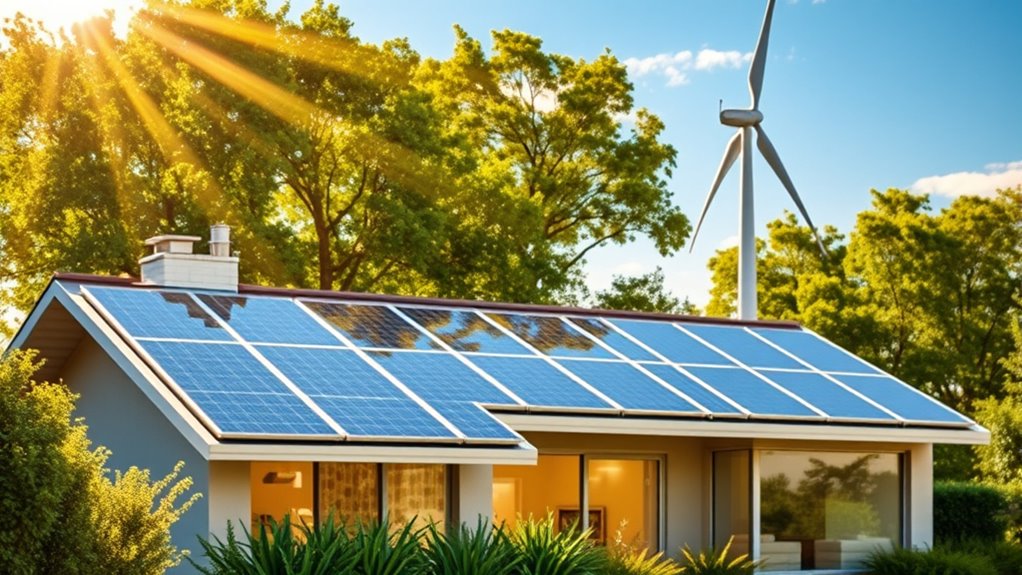
Installing solar panels can notably reduce your energy bills and carbon footprint. When choosing renewable sources, consider options that suit your home’s location and energy needs. Embracing solar energy not only benefits the environment but also boosts your home’s efficiency and value. High-efficiency solar panels ensure maximum energy capture and long-term savings.
Solar Panel Benefits
Have you considered how solar panels can transform your home’s energy use? Installing solar panels offers significant benefits, including reducing your electricity bills and decreasing your carbon footprint. With proper solar panel maintenance, you ensure your system stays efficient and lasts longer, maximizing your investment. Solar panels also increase your home’s value and provide energy independence. When it comes to solar panel installation tips, proper placement and secure mounting are key to optimizing sunlight exposure. Plus, many regions offer incentives and tax credits, making the switch even more affordable. Overall, harnessing solar energy not only saves you money but also supports a cleaner environment, making it a smart upgrade for any eco-conscious homeowner.
Choosing Renewable Sources
Choosing renewable sources for your home’s energy needs is a smart way to reduce reliance on fossil fuels and lower your carbon footprint. Solar panels are a popular option, but you can also consider geothermal heating systems, which use the earth’s stable underground temperature to provide efficient heating and cooling. Wind energy systems are another effective choice if you have enough space and consistent wind speeds. These options not only help you cut energy costs but also contribute to a cleaner environment. By combining solar, geothermal, and wind energy, you create a diversified and reliable renewable energy setup that maximizes efficiency. Additionally, understanding the energy source compatibility of these systems can help optimize their performance and integration into your home. Making these choices guarantees your home becomes more sustainable and less dependent on nonrenewable resources.
Add Weatherstripping and Door Sweeps
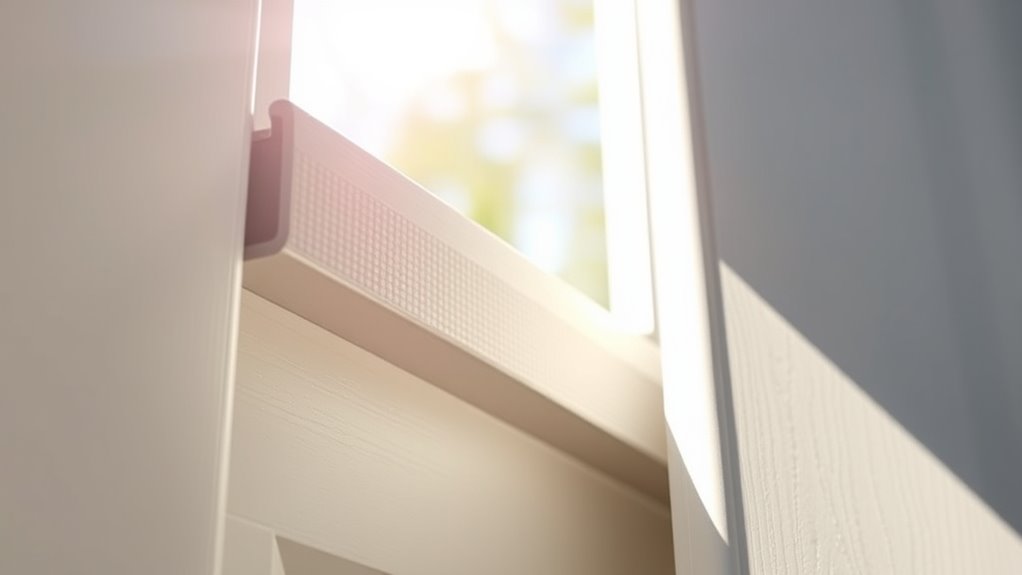
Adding weatherstripping and door sweeps is one of the most straightforward ways to improve your home’s energy efficiency. Start by sealing gaps around your doors, especially on storm doors and main entryways. High-quality door seals prevent drafts, keeping warm air in during winter and cool air in during summer. Installing door sweeps at the bottom of exterior doors blocks out cold air, pests, and debris. For storm doors, ensure they have proper weatherstripping to create an effective barrier against drafts. These simple upgrades reduce heat loss and lower your energy bills without significant expense. Regularly inspect and replace worn or damaged weatherstripping to maintain a tight seal. Using essential oils for energy efficiency can also contribute to a more comfortable and inviting home environment. Small improvements like these can make a noticeable difference in your home’s comfort and energy savings.
Incorporate Smart Home Technology
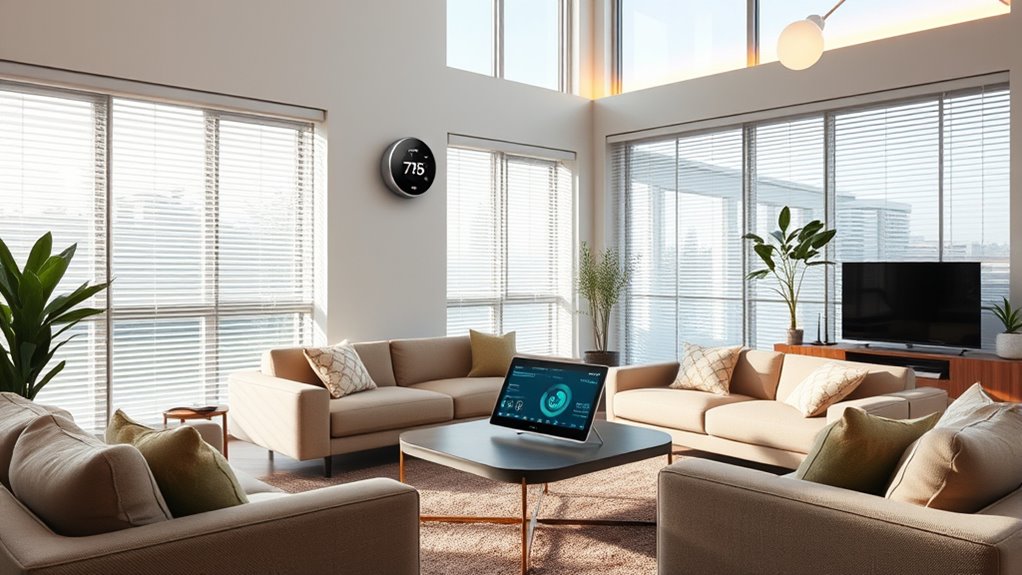
Smart home technology can considerably boost your energy efficiency. Installing a smart thermostat lets you control your home’s temperature remotely and automatically adjusts for ideal savings. Automated lighting controls ensure lights turn off when not in use, reducing unnecessary energy consumption. Additionally, integrating tuning techniques used in Hyundai vehicles, such as engine remapping and efficiency enhancements, can inspire innovative ways to optimize your home’s energy performance.
Smart Thermostats Enhance Efficiency
By integrating smart thermostats into your home, you can markedly improve energy efficiency and reduce heating and cooling costs. A smart thermostat learns your schedule and preferences, adjusting temperature settings automatically for ideal comfort and efficiency. This efficiency enhancement ensures your system runs only when needed, preventing energy waste. With remote access via smartphone apps, you can fine-tune your home’s temperature anytime, even when you’re away. Many models also provide detailed energy usage reports, helping you identify patterns and further maximize savings. Installing a smart thermostat is a simple upgrade with significant benefits, allowing you to control your climate more effectively while lowering utility bills. Overall, it’s a smart step toward making your home more energy-efficient and environmentally friendly.
Automated Lighting Controls
Have you considered how automated lighting controls can boost your home’s energy efficiency? With dimming automation, you can adjust your lights based on natural light levels or time of day, reducing unnecessary energy use. Occupancy sensors detect when a room is empty, automatically turning off or dimming the lights, ensuring you never waste electricity. These smart controls create a seamless experience, eliminating the need to manually switch lights on or off. Implementing automated lighting not only cuts energy costs but also extends the lifespan of your bulbs. By integrating these features into your home, you gain greater control over your energy consumption while enhancing convenience and comfort. Automated lighting controls are a simple, effective upgrade for any energy-conscious homeowner.
Frequently Asked Questions
What Is the Typical Payback Period for Energy-Efficient Upgrades?
When considering the payback period for upgrades, you should perform a detailed payback analysis to determine how long it takes to recover your investment through energy savings. Typically, the upgrade timeline ranges from 3 to 10 years, depending on the project’s scope and efficiency gains. By understanding this, you can make informed decisions and guarantee your investment aligns with your long-term energy and cost-saving goals.
Are There Government Incentives or Rebates Available for Home Energy Upgrades?
You can take advantage of government incentives like tax credits and rebate programs for home upgrades. These programs often provide significant savings, making improvements more affordable. Check with local and federal agencies to find current offers, as they vary by location and project type. By utilizing these incentives, you reduce your upfront costs and enjoy long-term energy savings, making upgrades more accessible and financially rewarding.
How Do I Prioritize Which Upgrades to Implement First?
Did you know that prioritizing upgrades can cut your energy costs by up to 30%? To decide which upgrades to do first, start with budget planning and assess what offers the biggest savings or comfort improvements. Focus on upgrade sequencing—like sealing leaks before installing new windows—to maximize efficiency. This approach helps you allocate funds wisely, ensuring each step delivers the best value and prepares your home for future improvements.
Will These Upgrades Increase My Property’S Resale Value?
When considering if upgrades will boost your resale value, think about how they impact your home appraisal. Energy-efficient improvements often increase your property’s appeal to buyers, potentially raising its resale value. You can expect upgrades like new windows or insulation to make your home more attractive. Keep in mind, though, the actual increase depends on the local market and the specific upgrades you choose. Overall, smart upgrades can positively influence your home’s resale value.
What Maintenance Is Required for Renewable Energy Systems Like Solar Panels?
Think of your renewable energy system as a garden that needs regular tending. You’ll want to keep your solar panels clean through periodic solar panel cleaning to maximize efficiency. Additionally, inverter maintenance is essential to make sure your system runs smoothly; check for any warning signs and have a professional inspect it annually. This ongoing care keeps your solar setup humming happily, saving you money and energy for years to come.
Conclusion
By improving insulation and sealing, upgrading windows, installing smart thermostats, switching to LED lighting, and embracing renewable energy, you create a more energy-efficient home. Enhancing ventilation, adding weatherstripping, and incorporating smart technology further reduce waste and lower costs. Each step builds on the last, each upgrade empowers your savings, each choice contributes to sustainability. Together, these enhancements transform your house into a smarter, greener, more comfortable home, making every effort count toward a better tomorrow.
